Sergal
![naar website Sergal [Mantua Model UK]](https://www.vmbchetanker.nl/wp-content/themes/default/images/Sergal-logo.jpg) |
Sergal kits maken onderdeel uit van het merk Mantua Model UK. |
| Naam | Omschrijving | Afbeelding |
|---|---|---|
| Mississippi 1870 | This is a beautiful model of a typical American steamboat that operated from the 1870’s to 1920’s. the shallow draft of these fine boats allowed them to navigate all but the smallest of the main rivers. The kit of the Mississippi features a double plank on frame hull construction, building plans with general details, English instructions, lost wax brass castings, walnut and lime planking, wooden masts and spars, brass and walnut fittings, etched brass details, aluminium smoke stacks rigging cord and silk flags. All sheet ply sections are laser cut for accuracy. This kit can also be motorised (experienced modellers). Specifications: Scale 1:50 Overall Length: 1050mm Overall Width: 240mm Height: 540mm |  |
| Vasa Man of War | In the early 17th century, Sweden was busy building an empire around the Baltic Sea in northern Europe. A strong navy was essential. During the 1620s Sweden was at war with Poland. In 1625 the Swedish king Gustavus Adolphus ordered new warships. Among them the Vasa. The Vasa was built at the Stockholm shipyard by Henrik Hybertsson - an experienced Dutch shipbuilder. His experience was much needed as the Vasa was to be the mightiest warship in the world, armed with 64 guns on two gundecks. In 1628 the ship was ready. Sunday August 10 was the day of the Vasa's maiden voyage. The beaches around Stockholm were filled with spectators, among them foreign diplomats. The maiden voyage was to be an act of propaganda for the ambitious Swedish king Gustavus Adolphus. The Vasa set sail and fired a salute. But only after a few minutes of sailing the ship began to heel over. She righted herself slightly - and heeled over again. Water started to gush in through the open gunports. And, to everyones horror and disbelief, the glorious and mighty warship suddenly sank! Of the 150 people on board, 30-50 died in the disaster. When Vasa had been salvaged in 1961, archaeologists found the remains of 25 skeletons. After the disaster the captain of the Vasa - Söfring Hansson - was arrested. The Swedish king Gustavus Adolphus was not in Sweden at the time. He was waging war in Poland. It took two weeks for him to learn about what had happened. When he did, he wrote angrily that the disaster had happened because of "imprudence and negligence" and that the guilty parties had to be punished. Söfring Hansson and many others were called to inquiries at the Royal Castle of Stockholm. At the inquest people were troubled by the fact that the shipbuilder Henrik Hybertsson had died the year before the Vasa was completed. Instead his brother and partner, Arendt de Groot, was held responsible for the completion of the ship. But in the end no one was condemned for causing the disaster. The people in charge of the inquiries concluded that the ship was well built - but badly proportioned. The kit of the Vasa Features ddouble plank on frame hull construction, building plans with general details, English instructions, lost wax brass castings walnut and lime planking, wooden masts and spars, brass and walnut fittings, etched brass details, rigging cord and silk flags. All sheet ply sections are laser cut for accuracy. Specifications: Scale 1:60 Overall Length: 1180mm Overall Width: 420mm Length of Hull: 1030mm Width of Hull: 80mm |  |
| HMS Victory 1:78 | This kit makes up into a fine model of the flagship to Admiral Lord Nelson during the battle of Trafalgar on 21st October 1805 and is the most famous of the great British fighting ships. She can be visited at Portsmouth dockyard where she is preserved for posterity.A plank on frame construction, the kit contains:- Building plans with general details English instructions, lost wax brass castings walnut or lime planking, wooden masts and spars, brass and walnut fittings, laser etched details, rigging cord and silk flag. (the stern gallery parts are now supplied in laser etched wood, not brass as in some pictures) All sheet ply sections are laser cut for accuracy. Same size as 738 HMS Victory kit but without the copper tiles for below the waterline. Scale 1:78 Length: 1300mm Width: 450mm Height: 920mm |  |
| HMS Jamaica | The 14 gun sloop Jamaica was built in the Bermuda dockyard in 1710. She was purchased to act as a cruiser for the West Indian trade companies. The kit of the features a double plank on frame hull construction, building plans with general details, English instructions, lost wax brass castings, brass and walnut fittings, walnut and lime planking, wooden masts and spars, rigging cord and silk flag. Material for sails as shown are an optional accessory and a pre-stitched sail set is also available. Scale 1:45 Length 810mm | 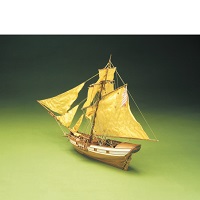 |
| HMS Bounty | The name of the Bounty, frigate of the British Navy, is famously tied to its captain's Bligh and the mutiny of the crew. The ship set out Spit head in December 1787, final destination Tahiti. On the return voyage, owing to the strict discipline imposed by the captain, which clashed with the idle stay in Tahiti, a certain discontent began to spread through the crew and it soon turned into a mutiny. Christian Fletcher, the boatswain, took command of the ship and forced Bligh to embark on a life-boat with 18 still faithful men. After a dangerous navigation for more than 4000 miles, Bligh reached the isle of Timor and afterwards England. The Bounty went back to Tahiti where part of the crew landed. Then it sailed for the Pitcairn Isle where Fletcher and the remaining men settled. Only 20 years later the group landed in Tahiti was captured and tried by the English Court-martial. Only three seamen where condemned, while the others were acquitted. The kit of the Bounty Features a double plank on frame hull construction, building plans with general details, English instructions, lost wax brass castings walnut and lime planking, wooden masts and spars, brass and walnut fittings, laser engraved details, rigging cord and silk flag. All sheet ply sections are laser cut for accuracy. Material for sails as shown are an optional accessory and a pre stiched sail set is also available. Scale 1:60 Overall Length: 810mm Overall Width: 310mm Height: 620mm |  |
| HMS Peregrine | This fast cruiser was used to connect England with the North American colonies and was generally referred to as one of the "runner class". She was built at the Deptford dockyard on the river Thames in 1700. She was later rebuilt and renamed the Caroline. When she was disposed of in the mid 18th century, the design was copied and used as a basis for the yacht Royal Caroline which was very similar in overall appearance. The kit of the Peregrine features a double plank on frame hull construction, building plans with general details English instructions, lost wax brass castings, walnut and lime planking, wooden masts and spars, brass and walnut fittings, laser engraved details, rigging cord and silk flag. All sheet ply sections are laser cut for accuracy. Material for sails as shown are an optional accessory. Scale 1:60 Overall Length: 925mm Overall Width: 280mm Height: 630mm Van deze boot is er een manual [of meer dan 1] te vinden op de pagina Modellen Manuals [Deze pagina is voor iedereen toegankelijk] | 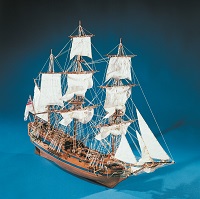 |
| Sovereign Of The Seas | This beautiful ship was commissioned by King Charles 1st. and designed and built by Phineas Pett. She was launched in 1637 and set the design of ships for the next 200 years. No such lavish display of ornamentation had ever been seen before nor, since and the cost was astronomical.A plank on frame construction, the kit contains:- Building plans with general details English instructions, lost wax brass castings walnut or lime planking, wooden masts and spars, brass and walnut fittings, laser etched details, rigging cord. All sheet ply sections are laser cut for accuracy. A full colour poster is provided with the kit to show the beauty of the finished model. Scale 1:78 Length: 1100mm Width: 435mm Height: 865mm | 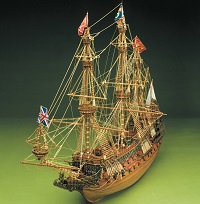 |
| Cutty Sark 1869 | The Cutty Sark was built at Scott and Lintons yard, Dumbarton, Scotland in 1869 for the traffic with the far South East and Africa. She was designed to rival the Thermopylae, one of the finest clippers ever built, which she did for many years. She now resides at the National Maritime Museum, Greenwich. A plank on frame construction, the kit contains:- Building plans with general details English instructions, lost wax brass castings walnut or lime planking, wooden masts and spars, brass and walnut fittings, laser etched details, rigging cord and copper plates for the hull. All sheet ply sections are laser cut for accuracy. Scale 1:78 Length 1150mm. | 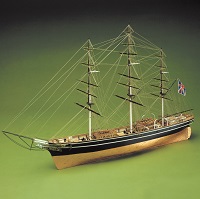 |
| Dutch Whaler | This is a fine reproduction of an 18th. century ship used by the Dutch as a whaling ship, this is a rare historical reproduction of a loading ship of the northern seas. A plank on frame construction, the kit contains:- Building plans with general details English instructions, lost wax brass castings walnut or lime planking, wooden masts and spars, brass and walnut fittings, laser etched details, rigging cord and silk flag. All sheet ply sections are laser cut for accuracy. Scale 1:60 Length 700mm |  |
| Thermopylae | Thermopylae was designed for the China tea trade, and set speed records on her maiden voyage to Melbourne - 63 days, still the fastest trip under sail. In 1872 she raced the clipper Cutty Sark from Shanghai back to London and won by seven days after Cutty Sark lost her rudder. In 1895 she was sold to Portugal and used as a naval training ship. The Portuguese Navy torpedoed her at sea in 1906. The kit of the Thermopylae features a double plank on frame hull construction, building plans with general details, English instructions, lost wax brass castings, walnut OR lime planking, wooden masts and spars, brass and walnut fittings, laser etched detailing, rigging cord and silk flag. All sheet ply sections are laser cut for accuracy. Scale 1:124 Length 575mm Van deze boot is er een manual [of meer dan 1] te vinden op de pagina Modellen Manuals [Deze pagina is voor iedereen toegankelijk] |  |
| HMS President | The HMS President is a fine model of a typical light frigate built in Britain in the early 1700’s. These ships were very fast and manoeuvrable and helped to give English supremecy of the seas during these troubled times. The kit of the President features a double plank on frame hull construction, building plans with general details, English instructions, lost wax brass castings walnut or lime planking, wooden masts and spars, brass and walnut fittings, laser etched details, rigging cord and silk flags. All sheet ply sections are laser cut for accuracy. Scale 1:60 Overall Length: 520mm Overall Width: 205mm | 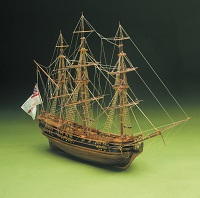 |
| HMS Racehorse | The HMS Racehorse is a scale model reproduction of a ketch strengthened by the British for Arctic exploration which also had the ability to withstand the pressures of large mounted mortars and were referred to as "Bomb vessels", the Racehorse together with similar vessels was used during the wars with Russia. Nelson served as midshipman on a similar ship to this model. The kit of the Racehorse features a double plank on frame hull, construction, building plans with general details, English instructions, lost wax brass castings, walnut and lime planking, wooden masts and spars, brass and walnut fittings, etched details, rigging cord and silk flag. All sheet ply sections are laser cut for accuracy. Scale 1:47 Overall Length: 590mm Overall Width: 205mm Height: 515mm Van deze boot is er een manual [of meer dan 1] te vinden op de pagina Modellen Manuals [Deze pagina is voor iedereen toegankelijk] | 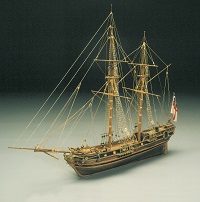 |
| Achilles 1812 | The Achilles was originally named "Anna Maria", she was built in 1815 at the New York dockyards as a pilot boat. The "Achilles" spent much of her time as a fast mail boat. The kit of the Achilles Feature a double plank on frame hull construction, building plans with general details English instructions, lost wax brass castings walnut and lime planking, wooden masts and spars, brass and walnut fittings, laser engraved details, rigging cord and silk flag. All sheet ply sections are laser cut for accuracy. Scale 1:43 Length 565mm Van deze boot is er een manual [of meer dan 1] te vinden op de pagina Modellen Manuals [Deze pagina is voor iedereen toegankelijk] | 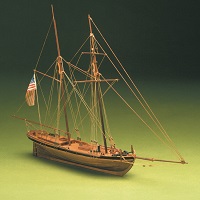 |
| French Xebec | The term xebec refers to a small, fast vessel of the 16th to 19th centuries which were used almost exclusively in and around the Mediterranean Sea. The Earliest Xebecs had two masts; the later ones were equipped with three. Xebecs featured a distinctive hull with pronounced overhanging bow and stern, and rarely displaced more than 200 tons, making them slightly smaller and with slightly fewer guns than frigates of the period. In the 18th and early 19th centuries, a large xebec carried a square rig on the foremast, lateen sails on the other masts, a bowsprit, and two headsails. The square sail distinguished the form of a Xebec from that of a felucca. Sea-going Mediterranean peoples greatly favoured Xebecs as corsairs, and for this purpose built them with a narrow floor to achieve a higher speed than their victims, but with a considerable beam in order to enable them to carry an extensive sail-plan. When used as corsairs they carried a crew of 300 to 400 men and mounted perhaps 16 to 40 guns according to size. In peacetime operations, the xebec was used to transport merchandise. The kit of the Xebec features a double plank on frame hull construction, building plans with general details, English instructions, lost wax brass castings, walnut and lime planking, wooden masts and spars, brass and walnut fittings, etched detailings, rigging cord and silk flags. All sheet ply sections are laser cut for accuracy. Scale 1:49 Length 520mm | 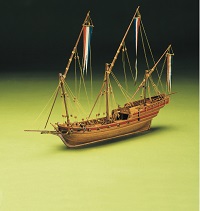 |
| Le Soleil Royal | In all four ships have carried the name Soleil Royale but only the second ever won renown. She was launched from Brest in the late 1600s and took part in the battle of Barfleur, however she would have been remembered for her beauty alone the design and ornamentation were of such extravagance to have won a place in naval history. The battle of Barfleur began on19th. May 1692 and lasted for almost two days. Having been badly damaged she disengaged together with three others and was sytematically destroyed by cannon shot and fire, by the Anglo/Dutch fleet. It was reported that her destroyers were ashamed to be a part of her demise. A plank on frame construction, the kit contains:- Building plans with general details English instructions, lost wax brass castings walnut or lime planking, wooden masts and spars, brass and walnut fittings, laser etched details, rigging cord and silk flags. All sheet ply sections are laser cut for accuracy. Scale 1:77 Length: 1030mm Width: 440mm Height: 765mm | 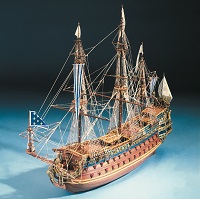 |





